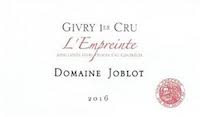Always one of my favourite tastings: the new vintage – in this case the 2019s – of Domaine Joblot’s wines from the bottle and, better still, in the comfort of my own home. 2019 has been much lauded but, thanks to Covid, only a very few people have tasted widely around the vintage. Jancis Robinson said of the wines she tasted, ‘the wines were delightfully easy to like’ although she rarely looks at the Chalonnaise which can be viewed as unfortunate for the top estates there but, perhaps, lucky for us since it keeps prices down and wines available. Anyone wanting to delve into Joblot’s wines could either choose any available vintagesand try wines from across the range or follow particular cuvées across a range of vintages (horizontal or vertical comparisons).
Juliette was clearly pleased with the way the wines turned out and rightly so. They tend towards sweetness in their youth but that is necessary for the wines to show at their best after 5-10m years (they will last much, much longer though). Give them 10 minutes in the glass and they will start to shine already though. Each of these wines was tasted over several days which demonstrated well their capacities to age fabulously.
The wines were tasted in the order listed. This is not to suggest that any cuvée is better than the ones preceding it (except that it is reasonable to assume that Preface is the simplest and Empreintes the most interesting). It is simply the order I have always tasted them.
Bois Chevaux: much richer and more complex on the nose. The palate is sweeter – jammier – with lots of pepper and lively, dancing tannins which soften quickly enough for the glass to be enjoyable even now. Fuller bodied, richer and altogether more substantial. 2023-2030.
Clos Marole: as always, the first of the Premier Cru wines to be bottled and, as always, a shade darker than the previous two wines. A little more black fruited as well – black plums. Quite undulating flavours, reminiscent of an autumn walk. Slightly chalky tannins. Very clean finish. 2022-2030.
Cellier aux Moines: again, another dimension. These wines are all so different (there wouldn’t be much point in different cuvees otherwise, of course). Lots of subtlety here and more evolution. Lots of sweetness. Tannins are quite soft. This wine is gorgeous already but it’s only going to get better. 2022-2030+.
Servoisine: the most powerful nose (so far) and more obvious tannins. True to form, this wine is about power compared with the previous wine’s finesse. Again, lots of sweetness with some sourness to counter this. Needs longer. 2024-2030+.
Empreintes: the blend. It does combine the red fruit of Bois Chevaux, black fruit of Clos Marole, finesse of Cellier aux Moines and power of Servoisone. A fantastic wine but I won’t be opening any more of these for a while. 2024-2030+.

Comments
Post a Comment